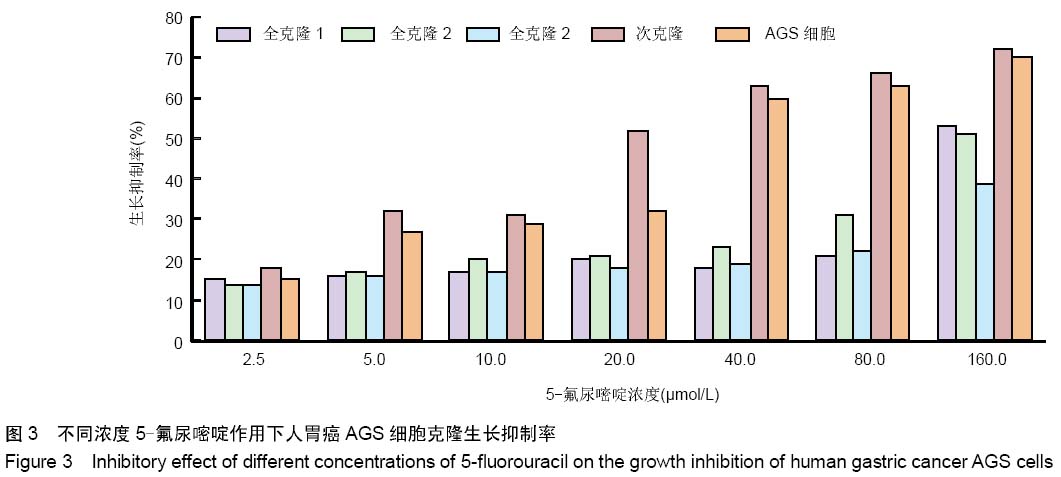| [1] 高伟波,陈书长,赵春华,等.肿瘤干细胞与肿瘤耐药[J].基础医学与临床,2006,26(6):662-667.
[2] Heimberger AB, Sampson JH. The PEPvIII-KLH (CDX-110) vaccine in glioblastoma multiforme patients. Expert Opin Biol Ther. 2009;9(8):1087-1098.
[3] 胡蕴慧,盛梦瑶,张孝云,等.miR-106b~25基因簇增强乳腺癌MCF-7肿瘤干细胞相关耐药性[J].中国药理学通报,2013,29(8): 1070-1075.
[4] 韩娜,穆永慧,张庆,等.肿瘤干细胞在人乳腺癌细胞株MCF-7耐紫杉醇效应中的作用[J].中华实验外科杂志,2014,31(7): 1482- 1484.
[5] 杨栋,张培彤.肿瘤干细胞在恶性肿瘤发生、耐药、侵袭及转移中的作用[J].实用癌症杂志,2015,30(4):629-632.
[6] 安勇,姚捷,卫积书,等.吉西他滨耐药人胰腺癌细胞株的建立及其与肿瘤干细胞的相关性研究[J].中华外科杂志,2010,48(13): 999-1003.
[7] 符昱,舒鹏.胃癌干细胞的研究进展[J].中国中西医结合消化杂志, 2013,21(11):608-610.
[8] 林碧华,陈婧,郭春连,等.鼻咽癌肿瘤干细胞高表达SOD2可对抗顺铂的杀伤作用[J].天津医药,2015,43(6):577-581.
[9] 周志华,张建东,徐桂芳,等.基于克隆形态分选胃癌干细胞及其对氟尿嘧啶敏感性的检测[J].中华胃肠外科杂志,2013,16(4): 376-380.
[10] Li H, Chen X, Calhoun-Davis T, et al. PC3 human prostate carcinoma containing self-renewing tumor-initiating cells. Cancer Res. 2008; 68: 1820-1825.
[11] 许浪.顺铂对人胃癌SGC7901细胞株中干细胞的影响[J].中国老年学杂志,2014,34(13):3762-3763.
[12] Kodach LL, Jacobs RJ, Voorneveld PW, et al. Statins augment the chemosensitivity of colorectal cancer cells inducing epigenetic reprogramming and reducing colorectal cancer cell 'stemness' via the bone morphogenetic protein pathway. Gut. 2011;60(11):1544-1553.
[13] 荣黎,吴小翎.胃癌SGC-7901细胞株侧群细胞分选及生物学特性的初步研究[J].中国生物工程杂志,2011,31(11):38-43.
[14] 陈建新,王均惠,彭永海,等.胃癌干细胞的研究现状及发展方向[J].中华肿瘤杂志,2014,36(11):801-804.
[15] Kim KY, Yi BR, Lee HR, et al. Stem cells with fused gene expression of cytosine deaminase and interferon-β migrate to human gastric cancer cells and result in synergistic growth inhibition for potential therapeutic use. Int J Oncol. 2012 Apr;40(4):1097-1104.
[16] 徐志远,程向东,张格尔,等.体外化疗后残余胃癌细胞干细胞特性的研究[C].第8届全国胃癌学术会议暨首届阳光长城肿瘤学术会议论文集,2013:103-104.
[17] 徐志远,程向东,杜义安,等.化疗后残余胃癌细胞发生上皮间质转化的体外研究[J].中国肿瘤临床,2013,40(18):1085-1088.
[18] 张娜.5-氟尿嘧啶联合DC-CIK细胞对胃癌细胞及其侧群细胞杀伤作用的体外研究[D]. 承德:承德医学院,2014.
[19] 陈军,崔有宏,郝迎学,等.5-氟尿嘧啶及长春新碱对胃癌细胞SGC-7901干细胞相关特性的影响[J].第三军医大学学报,2013, 35(12):1247-1251.
[20] 胡梅洁,曾晖,章永平,等.苦参碱联合5-氟尿嘧啶对人胃癌裸鼠移植瘤的抑制作用[J].中华消化杂志,2005,25(4):219-221.
[21] 姜伟,李锦毅,吴婷,等.胃癌侧群细胞的耐药性及致瘤性的初步研究[J].临床肿瘤学杂志,2012,17(8):673-677.
[22] 吴婷,李锦毅,陆士新.人胃癌侧群细胞的分离鉴定和生物学特性分析[J].中华肿瘤杂志,2012,34(4):264-268.
[23] 王嘉,俞继卫,吴巨钢,等.骨髓间充质干细胞调控人胃癌细胞生物学特性的实验研究[J].中华胃肠外科杂志,2015,18(2):159-165.
[24] 王守练,俞继卫,蔡成,等.RNA干扰抑制KATO-Ⅲ CD133阳性胃癌细胞CD133基因表达及对其生物学特性的影响[J].中华胃肠外科杂志,2013,16(9):889-894.
[25] Ding XW, Wu JH, Jiang CP. ABCG2: a potential marker of stem cells and novel target in stem cell and cancer therapy. Life Sci. 2010;86(17-18):631-637.
[26] Zen Y, Fujii T, Yoshikawa S, et al. Histological and culture studies with respect to ABCG2 expression support the existence of a cancer cell hierarchy in human hepatocellular carcinoma. Am J Pathol. 2007;170(5):1750-1762.
[27] Monzani E, Facchetti F, Galmozzi E, et al. Melanoma contains CD133 and ABCG2 positive cells with enhanced tumourigenic potential. Eur J Cancer. 2007;43(5):935-946.
[28] Morgan J, Jackson JD, Zheng X, et al. Substrate affinity of photosensitizers derived from chlorophyll-a: the ABCG2 transporter affects the phototoxic response of side population stem cell-like cancer cells to photodynamic therapy. Mol Pharm. 2010;7(5):1789-1804.
[29] Kamohara Y, Haraguchi N, Mimori K, et al. The search for cancer stem cells in hepatocellular carcinoma. Surgery. 2008;144(2):119-124.
[30] 陈浩,黄烨,张克难,等.人胃癌SGC7901细胞株中干细胞对顺铂耐药的作用机制探讨[J].中国现代医学杂志,2013,23(17):25-29.
[31] 杨浪.胃癌干细胞的分离鉴定及其在胃癌侵袭转移中的作用与分子机制[D].重庆:第三军医大学,2013.
[32] 倪苏婕,赵丽琴,王小凤,等.多梳家族蛋白CBX7调控胃癌干细胞样特性的功能和机制研究[C].第9届全国胃癌学术会议暨第二届阳光长城肿瘤学术会议论文集,2014:32-34.
[33] 贺龙君.小干扰RNA抑制巨噬细胞游走抑制因子的表达对胃癌AGS细胞增殖的抑制作用[D].广州:中山大学,2009.
[34] Haraguchi N, Utsunomiya T, Inoue H, et al. Characterization of a side population of cancer cells from human gastrointestinal system. Stem Cells. 2006;24(3):506-513.
[35] Lei Z, Tan IB, Das K, et al. Identification of molecular subtypes of gastric cancer with different responses to PI3-kinase inhibitors and 5-fluorouracil. Gastroenterology. 2013;145(3): 554-565.
[36] 卓志红,张乐鸣,牧启田,等. 二十二碳六烯酸联合5氟尿嘧啶对胃癌细胞生长及bcl-2、bcl 2l12和bax表达的影响[J].中华普通外科杂志,2009,24(1):66-70.
[37] 吴松洁,贾晓渊,钱其军,等.人胃癌细胞系BGC-823中SP细胞的耐药性研究[J].浙江理工大学学报,2008,25(5):573-577.
[38] 张丹瑛.壳聚糖-聚天冬氨酸-5氟尿嘧啶纳米粒子的制备及对小鼠SGC-7901肿瘤生长抑制作用的研究[D].上海:复旦大学, 2008.
[39] 孙卯. CD44+胃癌细胞的肿瘤干细胞特性鉴定及其与癌侵袭相关性研究[D]. 重庆:重庆医科大学,2013.
[40] 李霞,徐桂芳,张伟杰,等.胃癌干细胞的分离鉴定以及干细胞特性研究[J].胃肠病学,2014,19(9):517-522. |



lb.jpg)